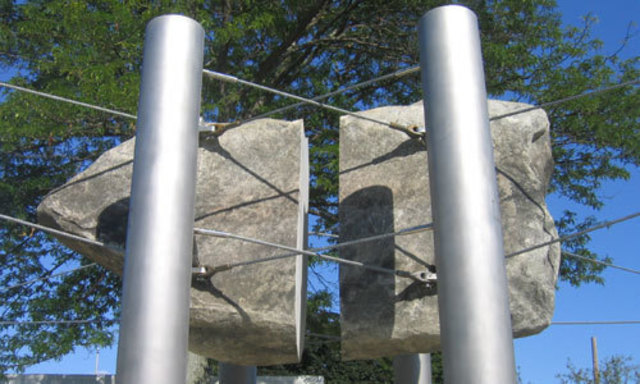
Description
MASS MoCA commissioned a new work by artist Don Gummer for the plaza outside the T. William Lewis Building on Marshall Street. The work, entitled Primary Separation, was first designed by Gummer in 1969, and has existed up to now only in maquette form: this is its first full-scale realization.
The installation consists of a massive granite boulder, 12 feet long by 6 feet tall, sawed in half. The stone halves - separated by just a 11-inch gap - are dramatically suspended 10 feet above ground, within a system of stainless steel supports and cables. A newly made plaza will form the base for the sculpture. Gummer's original inspiration for Separation was a stone that he felt resembled Brancusi's Fish. In using the stone, Gummer had Duchamp's readymades in mind, substituting for Duchamp's manmade objects an object found in nature.
"We are delighted to be able to create a permanent home for this signal work from Gummer's early career," said Joseph C. Thompson, Director of MASS MoCA. "Don first showed me the work in the form of a small model. We were just beginning work on the Northern Berkshire District Court, and, though Don was probably not thinking of issues of justice when he conceived the work (though perhaps he was, given the societal unrest of 1969), Primary Separation seemed to me a strikingly apt metaphor for the scales of justice massive weight sustained in balanced repose. The stone could be rising, or falling; separating, or re-joining. The thin margin between the two parts of the whole is charged with a powerful force, and it's not clear whether the force is repellent or attractive. We chose the placement of Primary Separation quite carefully, aligning it with MASS MoCA's entry corridor, the Clocktower, and Tree Logic. We hope that the siting will help to visually mark the Courthouse on Marshall Street, while also linking that complex with the rest of the MASS MoCA campus."
Details
- Work Date:
- 1969
- Credit Line:
- Supported by the William E. Simon Foundation, the Cynthia L. and William E. Simon, Jr. Foundation, and the Hidden Pond Foundation.